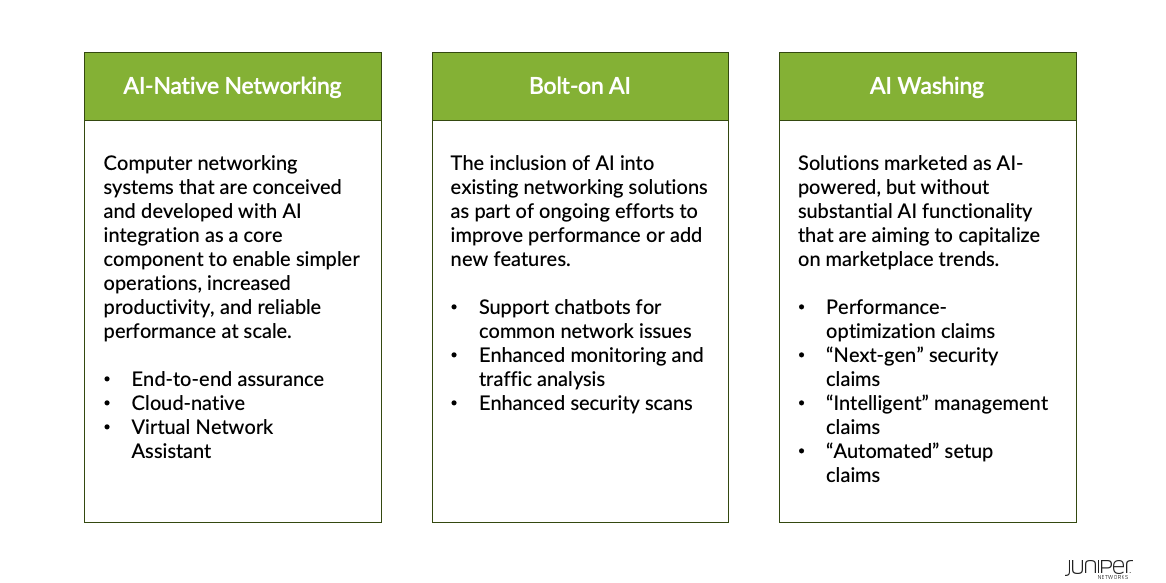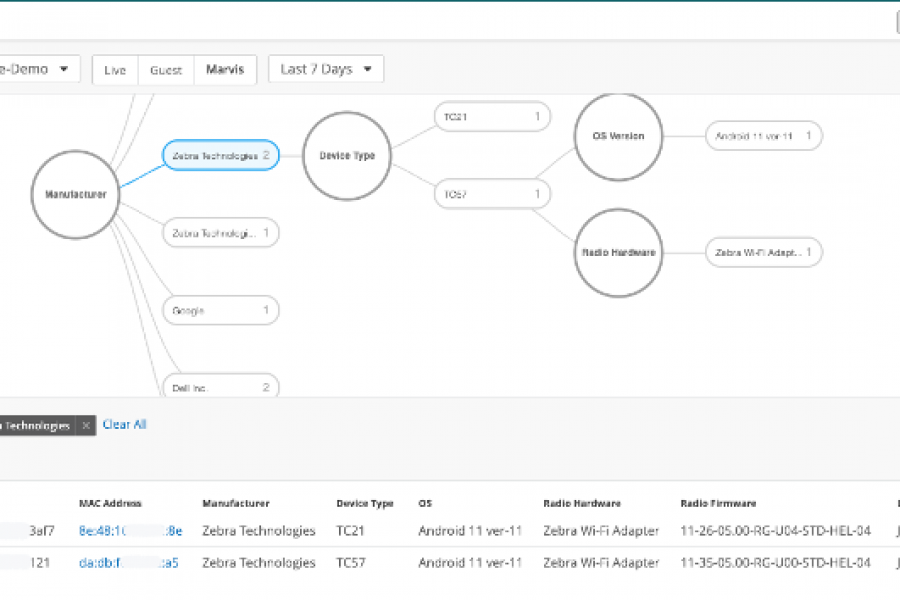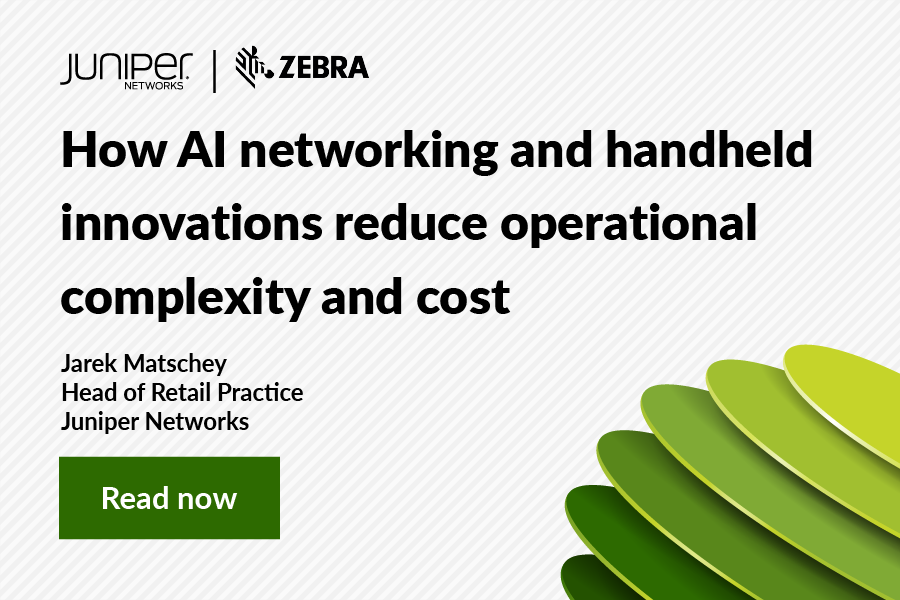In January, Juniper launched the Juniper AI-Native Networking Platform, aiming to redefine leadership in AI and networking. We felt it was important because we’re currently living in the “wild west” of AI innovation, which can make it hard to discern what types of AI capabilities are critical in networking and how they should be executed.
For us, AI-Native Networking means harnessing AI to improve NetOps, and developing networks specifically optimized for AI workloads. In other words, AI-Native is purpose-built for AI rather than adding AI as an afterthought. Here’s what that means at a high level vis-à-vis other options in the marketplace.

Unsurprisingly, the results these approaches deliver are dramatically different. So as more vendors start to make “AI-Native” claims about their solutions, it’s important to understand the foundational elements of AI-Native and why it’s so transformative in the networking space.
Three essential elements for AI-Native Networking
AI-Native Networking refers to both the AIOps layer that powers AI for networking and the robust systems designed to accommodate the heightened connectivity, volumes, and speeds necessary for building and deploying AI. True AI-Native infrastructure can be likened to a three-legged stool that includes:
- The right data—leverages comprehensive, real-time telemetry to deeply analyze networking activities, capturing data from every user and session for advanced analytics
- The right real-time response—provides comprehensive insights and self-improving service levels facilitated by a Virtual Network Assistant (VNA) that enables real-time response without human intervention
- The right secure infrastructure—designed to handle vast amounts of data securely, the infrastructure supports a Zero Trust security model to provide the right responses in real time
Juniper’s use of the word “platform” in AI-Native Networking Platform is crucial. It signifies that all the networking layers are integrated across a common cloud, AI toolset, and VNA, ensuring end-to-end assurance. Moreover, this integration is guided by concrete, strategic roadmaps.
Putting vendor claims to the AI-Native test
Since our January launch, we’ve noticed several other networking vendors starting to co-opt the AI-Native descriptor. And while we’re flattered by the imitation, it’s also frustrating to see what are clearly bolt-on and AI-washed solutions being described as AI-Native.
The recent Cisco Hypershield announcement is one example.
Cisco is touting that Hypershield is ushering in a new era of “AI-Native” security. As an outgrowth of the recent Splunk acquisition, Cisco Hypershield does add AI security capabilities to the ever-expanding Cisco portfolio, but the inclusion doesn’t seem to be part of a coherent AI-Native strategy. For example:
- Between Cisco’s existing platform and the announced Hypershield solution, nothing indicates a focus on the right data for continually improving security and experiences
- The data science in Hypershield is still in the early stages and Splunk is a data repository that was not designed from the ground up to be AI-Native
- The solution does not include a VNA
- Cisco doesn’t provide a single cloud or AI engine across all domains, let alone a microservices cloud
Juniper’s security is AI-Native and cloud-native—today
While the security promise of Hypershield is interesting, Juniper is already well ahead in AI-Native security integration. Not only is our platform built using the three-legged approach described above, we also offer a proven Zero Trust approach that complements a long-term vision of making every user experience exceptional. Here are a few examples of how our tightly integrated Connected Security solution delivers right real-time responses:
- Juniper Security Analytics (JSA) includes our implementation of the definitive market-leading SIEM, IBM QRadar, which has been named a Leader in the Gartner® Magic Quadrant™ for SIEM for 15 years in a row. Hypershield relies on complicated analytics that often depend on expensive talent to develop queries. Part of the appeal of JSA is its ease of use and flexible extensibility; it supports hundreds of plug-in applications to address nearly every security risk or compliance requirement for large enterprises.
- Juniper’s Connected Security firewalls have continuously outperformed Cisco’s security solutions in objective third-party testing since 2019.
- Juniper Security Director and Juniper Apstra work together to provide end-to-end management and orchestration for data centers. We offer simplified multicloud policy management that ensures consistent policies across private and public cloud environments. Moreover, we rely on real-time granular user state insights from Apstra to inform security and optimization orchestration.
AI-Native can never be an afterthought
At the end of the day, there is a lot more to an AI-Native Networking Platform than press releases and a PowerPoint. And solutions that focus on only one leg of the AI-Native stool aren’t sturdy.
Juniper’s AI capabilities and learning capabilities are the results of more than nine years of concentrated development and tuning. And our customers are already standing on our stool today—with amazing results, such as:
- Up to 90% fewer trouble tickets
- Up to 85% fewer truck rolls
- Up to 9x faster to deploy
We appreciate that other vendors increasingly recognize the value of purpose-built networks for AI and networks that use AI to optimize experiences and minimize costs. However, if you want a solution that captures the full potential of AI for networking and networking for AI, only one vendor delivers a true AI-Native Networking Platform. Juniper. And by the time other vendors start catching up to where we are, we’ll be that much further ahead.
Learn more
Read “What Does it Really Mean to Be AI-Native?” to learn more about Juniper’s AI-Native Networking Platform and how it brings end-to-end assurance across the wired access, wireless access, WAN, security, and data center domains.
Take a deep dive into what makes Juniper’s AI-Native Networking Platform tick and how it delivers better, more personalized experiences for operators and end users.


